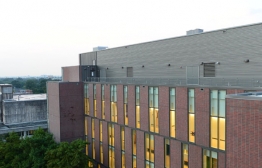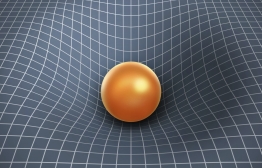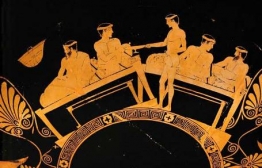As a Loyola student, you have the opportunity to work alongside our talented professors to partner in collaborative research. Learn more about some recent research and projects currently underway.
Making a better world: A project examining motivation to improve collective well-being
Dr. Chuck Nichols' project seeks to better understand the correlates, causes, and effects of wanting and working toward collective betterment. Caring about and helping close others and even complete strangers can provide strong psychological benefits for the helper as well as the helped. However, some surveys suggest that individuals may be becoming more selfish and less other-focused in recent decades, potentially undermining overall well-being. This project employs survey and experimental methodology to explore what leads people to care about and act to help others.
Senior Capstone Projects
The central component of the Department of Sociology's required Senior Capstone course is a one-to-one faculty-mentored, collaborative research project. The department also has a consistent record of incorporating students into grant funded research projects.
Below are examples of some of the recent Senior Capstone projects:
Twitter Wars: Social Media, Ethnicity, and Political Participation
Zahra Abdeljaber with Dr. Talukdar
Restore the Oaks: Public Art as Social Protest in the Historic Treme Neighborhood
Mark Gouda with Dr. Parham
Vulnerabilities to Trafficking Among Foster Care Youth
Molly Alper with Dr. MacGregor
The Lasting Impact of Participation in a Black Greek Letter Organization: An Examination of Social Capital
Eli Green with Dr. MacGregor
HIV in Prisons
Hannadi Mirfiq with Dr. Kondkar
Exploring the Gendered Curricula of Formal Sex Education
Callie Dorsey with Dr. Talukdar
School to Prison Pipeline
Eleni Roulakis with Dr. Capowich
Child Abuse as an Extension of Violence Against Women
Amy Cole with Dr. Kondkar
An Exploratory Study of Social Network Influences on Cultural Creativity in Popular Culture
Emily Bauer with Dr. Capowich
No Such Thing as a Free Lunch? Social Exchange Among the Hare Krishna
Caitlin Cowlen with Dr. Kondkar
The Role of Faith Based Initiatives in Corrections
Gianna Carbone with Dr. Voigt
The After School Zone of Kipp Central City Primary: A Case Study
Kelsey Coyle with Dr. Miron
Judging Books by Their Covers: An Intersectional Analysis of the Male Gaze and Attitudes toward Thinness
Marisa Gentler with Dr. MacGregor
Exploring the Relationship between Antidepressant Use and Suicide
Julie Castellini with Dr. Kondkar
National Identity After A Conflict
Dr. Natasha Bingham is writing a paper with a student entitled "Redefining National Identity after a Conflict: National Identity Formation among Northern Irish Youth."
Nanomaterial Synthesis
Dr. Heinecke’s research interests focus on nanomaterials synthesis and their applications in biomedicine and electronic devices. She is interested in 1) developing cationic nanomaterials as a platform for multivalent display of host defense peptides as novel antibiotic agents and 2) building defined molecular assemblies of these small materials for electron transport properties. This type of multidisciplinary research will afford students the opportunity to learn a wide variety of scientific techniques.
Effects of Rouseau Cane on Coastal Wetlands
For almost a quarter century, Loyola University New Orleans biologists and ecologists Donald Hauber, Ph.D., Craig Hood, Ph.D, David White, Ph.D., and several undergraduate honors students, have studied the origination and effects of the common reed known locally as Rouseau Cane on the marshes and coastal wetlands of southeast Louisiana.
Their findings, which detail the spread of this plant and its role in coastal protection, is found in a published study, “Genetic Variation in the Common Reed, Phragmites australis, in the Mississippi River Delta Marshes: Evidence for Multiple Introductions.”
“Rouseau Cane has dramatically increased in the coastal wetlands along the Atlantic and Gulf Coasts during the past century,” White said. “The species’ spread is mainly due to the introduction of new gene types from Europe. These invasive types are becoming more common in the interior marshes of the Mississippi River Delta, land that is extremely rich in nutrients.”
The Mississippi River Delta covers an area roughly 521,000 acres, but during the last 40 years, it has been significantly reduced due to lack of river sediment coupled with high natural subsidence.
P. australis is the dominant emergent vegetation in the Delta’s outer two-thirds and is believed to play a major role in stabilizing these extensive marshes by breaking wave action and storm surges from the open Gulf while also capturing and retaining river sediment. “This stabilizing role protects the diverse interior marsh communities that provide food and breeding habitat for wildlife, particularly birds,” said White.
In recent years however, the new European gene types of P. australis, have begun to expand into the interior marshes displacing food and habitat resources for wildlife. This new invasion into these inner marshes is thought to have negative impacts on sustaining the migratory and local wildlife.
In the study, Hauber, Hood and White identified several new DNA types of P. australis which were likely brought here by migratory birds, river currents or ships. These European types are increasing the species’ footprint in the delta at an alarming rate, according to White.
The researchers have been monitoring the spread of the Rouseau Cane through aerial views of the wetlands to study the impact from above.
White noted the massive impact of Hurricane Katrina on the wetlands. “Flying over the coast and the Mississippi Delta, it is a terrifying and powerful image because of what is no longer there and it proves to me that the city is more vulnerable to another significant storm surge than I previously imagined. If every citizen of Louisiana had this kind of flight opportunity, we’d be moving much quicker and with far more attention to protecting and restoring our coast.”
Flights have confirmed that the invasive types of P. australis is spreading throughout their research sites in the inner marshes of the delta. In a similar flight during the spring of 2006, White observed small areas of the invasive P. australis that are now much larger and spreading to other areas outside the delta. The Deepwater Horizon Oil Spill caused some coastal wetlands loss along the very margins of the delta’s shoreline, according to the researchers. "The total wetland loss in the delta is remarkably low as a result of the spill, though any loss is very troublesome,” White said. “The small amount of loss is partly due to the freshwater sheet flow that kept oil away from the delta freshwater wetlands, and partly because of the peripheral stands of the P. australis which became the frontline physical barrier to oil invasion inland.”
White, Hood and Hauber use photo images from wetland fly-overs to continue studying P. australis in their study areas. “The study of P. australis is central to the health and stability of the wetlands of the Mississippi River Delta,” said White.
Quantum Optics
Experiments using light quanta – photons – have proven to be very effective probes of a large range of phenomena, including quantum entanglement. This phenomenon has long fascinated scientists, and exemplifies the mystery and ‘weirdness’ of quantum physics. It also points the way towards the possibility in the future of extremely powerful quantum computers.
In the Quantum Optics Lab in the Physics Department at Loyola University we are in the process of setting up an experiment to explore quantum entanglement, in particular by testing something known as Bell’s theorem.
Students are involved in all aspects of the work, from putting together and aligning optical components to building electronics, to using computers to acquire, analyze and model the data.
A Within Host Model of Dengue Virus Infection
Dr. Jeremy Thibodeaux and senior mathematics student Michael Hennessey have derived a system of differential equations that model certain blood cell and particle populations in the body when it is infected with Dengue virus. The model aims to capture the relevant physiological processes to provide researchers a tool to develop more effective antiviral drugs and treatments in the fight against Dengue Fever.
Cosmology
Here are some current projects in cosmology involving undergraduate students.
Cyclic Inflation Model: Cyclic models envisage a universe that periodically expands and contracts, where time is endless not only in the future, but also in the past. The universe literally existed forever and there was never any beginning. If the cycles are asymmetric, that is in each the cycle the universe grows a bit more than it contracts, then over many-many such cycles the universe appears to "inflate" (grow exponentially). Below is a picture of the cyclic inflation phase followed by the usual slow power-law growth, a(t), represents the size of the universe.
That the universe once underwent an inflationary near-exponential growth has been pivotal to the success of the modern cosmological theory in explaining (and in some cases predicting) what one sees in our universe today. The cyclic inflation model, not only provides a viable mechanism to realize inflation but also comes with distinctive predictions for the cosmic microwave background radiation that our satellites are currently measuring. Here is a recent power point presentation on the subject.
Cyclic cosmologies in general provide an enigmatic alternative to the conventional monotonically expanding universe. There are quite a few interesting research projects in this direction that Dr. Biswas is planning to work on in the near future. If you are a physics or a math student who likes theoretical or computational work, you may want to explore the opportunity!
The Dark energy problem: Is the Dark energy just the Cosmological Constant as introduced by Einstein who later famously retracted it by saying that it was his “Biggest blunder”, or is there more to Dark energy than meets the “eye”? Cosmologists introduced dark energy to explain the cosmic speed-up, the fact that the expansion of our universe is speeding up rather than slowing down due to the gravitational attraction that exists between all "known" matter. In order to overcome gravity, dark energy has to have rather strange properties, such as having negative pressure and being impervious to dilution as the universe expands. This has lead many cosmologists to consider alternatives to the dark energy paradigm.
With collaborators and students, Dr. Biswas is currently looking into viable modifications of Einstein's theory of gravity that may be able to produce accelerating cosmologies without invoking dark energy. This is a follow up of his paper on viable gravitational theories on Minkowski background, including "non-local" (going beyond the paradigm that particles interact with each other at a given space-time point) modifications to Einstein's General theory of Relativity. Here is powerpoint presentation on the subject.
Gravitational Physics
Martin McHugh has for more than 10 years worked on the experimental search for gravitational waves – most recently as part of the large international collaboration known as LIGO. The goal of LIGO is first to make a direct verification of the existence of these waves, which are a prediction of Einstein’s theory of gravity – General Relativity. But probably more importantly, these waves, once discovered, will be a tool to study astrophysics, cosmology, and as a probe to a better understanding of the gravitational interaction.
Professor McHugh’s current research is somewhat of a departure from this previous work. He is working on a history of physics, more specifically a biography of Robert H. Dicke. Dicke made significant contributions in many areas of physics over the second half of the twentieth century. A short list of his accomplishments include the invention of the microwave radiometer, work in atomic physics on the narrowing of spectral lines by use of a buffer gas (sometimes referred to as ‘Dicke narrowing’), and foundational work on the theory of superradiance. But Dicke is best known for his work in gravitational physics – both his pioneering experiments, and his role in the development of the Brans-Dicke theory. The latter done with Loyola emeritus professor of physics Carl Brans when he was a graduate student at Princeton. Dicke also played a pivotal role in the discovery of the Cosmic Microwave Background.
Just Desserts
Dr. Karen Rosenbecker has an article “Just Desserts: Reversals of Fortune, Feces, Flatus, and Food in Aristophanes’ Wealth” that will appear in Harvard Studies in Classical Philology, vol. 108, spring 2015.








